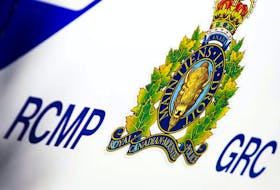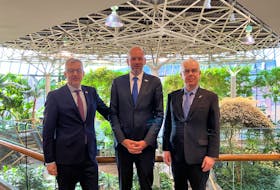The Civic Laboratory for Environmental Action Research (CLEAR) are waiting for donations — of fish guts, that is, from people coming back to shore with their cod from the recreational fishery. The researchers take the guts, bag and label them and bring them back to Memorial University (MUN), where they examine the intestines for tracers of plastic.
The members of CLEAR describe the group as a feminist marine science and technology lab with the goal of conducting research and building technology for populations that are affected by pollution, in particular. Their focus is on do-it-yourself, action-oriented research based in environmental monitoring.
Made up mostly of MUN students, CLEAR is led by sociology, geography and environmental sciences assistant professor Max Liboiron.
During last summer’s recreational fishery, the researchers examined 204 fish, finding plastics in only five of them. The ingestion rate among their samples was just 2.4 per cent: one of the lowest in the world.
Liboiron noted these fish were taken primarily from the eastern region of the island, where the Labrador Current flows. This summer, they’re planning to get samples from the southern part of the province, where the Gulf Stream passes. Liboiron expects the plastic ingestion rate to be higher among these samples.
“Newfoundland is a net exporter of marine plastics,” she said. “We do get some and it’s mostly fresh plastics. We’ve seen green shreds from shrimp trawls, fragments of white plastic from containers, bits of Tyvec sheeting, and a rope with a knot it in from one huge cod.”
The impact of plastics in the ocean isn’t limited to visible bits and pieces found in fish — plastics leak chemicals and act like sponges to soak up other substances, like toxins.
“You know how when you have chili in a plastic container you can’t scrub off the orange stain it leaves?,” Liboiron says by way of an example. Plastic can accumulate a million times more chemicals, she said.
“When animals eat them, the acid in their stomach makes the chemicals come out. Then other fish eat those fish and so on.”
Biomagnification— the increasing concentration of the toxins in higher levels of a food chain —makes this a special concern for humans.
Toxic plastics like BPA and phthalates, as well as the lead, mercury and cadmium contained in some plastic material, can pose dangerous health risks.
“If there is a high concentration of plastics — which there isn’t here — the risks are things like endocrine disruption, cancer, fetal development problems, obesity, autism and even feminization of the features in men. The list is quite long,” Liboiron said. “This is more of an issue during times when our endocrine system is really working hard, like in fetuses, in children and during puberty.”
The members of CLEAR are still looking for samples of cod and salmon, and will pick them up. On their website they give instructions on how to package the samples yourself: they need the fish guts from the mouth to the anus, preserved in zip-lock or tied plastic bags and frozen. A corresponding form is available on the website, where you’ll fill out where the fish was caught, and how long it was. If you give your fish a name or identifier, the members of CLEAR will post the results online under this name, so you can see exactly what was in your particular fish.
“A lot of people are naming their fish Nemo,” Liboiron says, chuckling.
More details on CLEAR’s work and how to submit your fish guts for testing (as well as some cool do-it-yourself technology developed by the members that you can build at home for research) can be found at www.civiclaboratory.nl .
The Civic Laboratory for Environmental Action Research (CLEAR) are waiting for donations — of fish guts, that is, from people coming back to shore with their cod from the recreational fishery. The researchers take the guts, bag and label them and bring them back to Memorial University (MUN), where they examine the intestines for tracers of plastic.
The members of CLEAR describe the group as a feminist marine science and technology lab with the goal of conducting research and building technology for populations that are affected by pollution, in particular. Their focus is on do-it-yourself, action-oriented research based in environmental monitoring.
Made up mostly of MUN students, CLEAR is led by sociology, geography and environmental sciences assistant professor Max Liboiron.
During last summer’s recreational fishery, the researchers examined 204 fish, finding plastics in only five of them. The ingestion rate among their samples was just 2.4 per cent: one of the lowest in the world.
Liboiron noted these fish were taken primarily from the eastern region of the island, where the Labrador Current flows. This summer, they’re planning to get samples from the southern part of the province, where the Gulf Stream passes. Liboiron expects the plastic ingestion rate to be higher among these samples.
“Newfoundland is a net exporter of marine plastics,” she said. “We do get some and it’s mostly fresh plastics. We’ve seen green shreds from shrimp trawls, fragments of white plastic from containers, bits of Tyvec sheeting, and a rope with a knot it in from one huge cod.”
The impact of plastics in the ocean isn’t limited to visible bits and pieces found in fish — plastics leak chemicals and act like sponges to soak up other substances, like toxins.
“You know how when you have chili in a plastic container you can’t scrub off the orange stain it leaves?,” Liboiron says by way of an example. Plastic can accumulate a million times more chemicals, she said.
“When animals eat them, the acid in their stomach makes the chemicals come out. Then other fish eat those fish and so on.”
Biomagnification— the increasing concentration of the toxins in higher levels of a food chain —makes this a special concern for humans.
Toxic plastics like BPA and phthalates, as well as the lead, mercury and cadmium contained in some plastic material, can pose dangerous health risks.
“If there is a high concentration of plastics — which there isn’t here — the risks are things like endocrine disruption, cancer, fetal development problems, obesity, autism and even feminization of the features in men. The list is quite long,” Liboiron said. “This is more of an issue during times when our endocrine system is really working hard, like in fetuses, in children and during puberty.”
The members of CLEAR are still looking for samples of cod and salmon, and will pick them up. On their website they give instructions on how to package the samples yourself: they need the fish guts from the mouth to the anus, preserved in zip-lock or tied plastic bags and frozen. A corresponding form is available on the website, where you’ll fill out where the fish was caught, and how long it was. If you give your fish a name or identifier, the members of CLEAR will post the results online under this name, so you can see exactly what was in your particular fish.
“A lot of people are naming their fish Nemo,” Liboiron says, chuckling.
More details on CLEAR’s work and how to submit your fish guts for testing (as well as some cool do-it-yourself technology developed by the members that you can build at home for research) can be found at www.civiclaboratory.nl .








